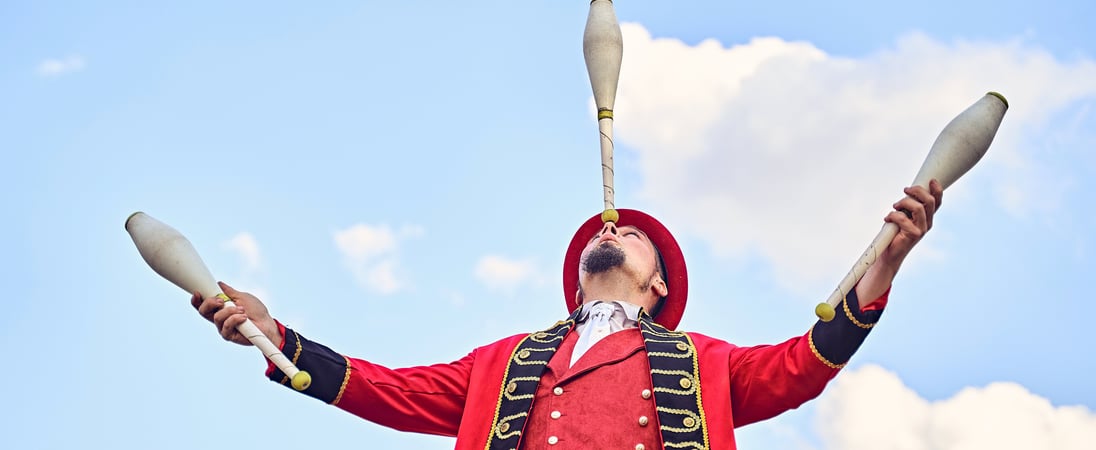
World Juggling Day
Go see a juggling performance, give one yourself, or take this opportunity to start learning and impress your friends and family, alleviate boredom, and show off.
Swirling and looping, rising and falling, the juggler’s tools fly through the air with an elegance surprising in pins and rings, knives, and hatchets. World Juggling Day recognizes the fantastic feats of dexterity and skill required by their demanding art form.
The types of things you can juggle and the styles of juggling are truly far and wide, and some of the most demanding don’t even require that they leave your hands.
If you’ve ever been amazed by the seeming magic worked by a juggler’s hands, then World Juggling Day is your opportunity to show them some recognition.
How to Celebrate World Juggling Day
Spend Time with a Juggler
If you know a juggler, the best way you can celebrate this holiday is complimenting them on their skill and perhaps even asking them to perform a little for you, so they have a chance to show off the art they worked so hard at.
Learn How to Juggle
If you’re feeling particularly adventurous, you might even take this opportunity to get out and learn a bit of juggling yourself! It’s a fairly simple art to learn, even if it’s incredibly hard to perfect, and it can improve your hand and eye coordination to an amazing degree!
Setting out on your juggling journey can be a daunting experience. Skilled professional jugglers make it look easy, even when juggling five or more objects. But, like most skills, it requires you to start with small challenges and then work from there.
The trick to juggling effectively is learning how to juggle two balls in one hand. This movement teaches you to toss the ball in your hand before the one in the air lands. Most people can pick up this skill in a day or two. After that, the next step is to throw balls between both hands while maintaining at least one in flight.
Share Juggling with Friends
If you do manage to develop your skills, you can celebrate World Juggling Day by posting your progress on social media. You can show off your skills. Plus, if you get good, you can combine juggling with other skills, like tightrope walking.
So on World Juggling Day, get out there and show your love to a juggler, or become one!
History of World Juggling Day
Juggling day was established by the International Jugglers Association and is dedicated to preserving and spreading the history of the art of juggling. Originally called National Juggling Day, this event got its start in the 1980s. Then, in 1995, the name was changed to World Juggling Day as it was inviting people from all over the globe to participate!
Juggling as an art form is far older than most people credit, going back well over 4,000 years.The first evidence of juggling as an art form goes back to the wall of a tomb in Egypt. A group of women is seen dancing and performing with up to three balls.
Other forms of juggling can be found in China, where the ancient Chu warrior Xiong Yiliao was reported to practice nòngwán, the art of “throwing multiple objects up and down without dropping.”
Apparently, his skills were so profound that he stepped out between the armies of Chu and Song, and promptly juggled nine balls, so astounding the Song troops that they turned and fled in terror. Such is the magic of juggling.From there on, the evidence of juggling can be found in Greece, the Roman Empire, on into Medieval Europe and modern-day.
Even the Native American’s have a strong history of traditional juggling, there’s even evidence of cultures having juggled with their feet. It’s somehow surprising that it took until 1947 for the International Jugglers’ Association to be formed.
After the fall of Rome and the chaos of the Dark Ages, juggling went into decline. There are few records of people engaging in the activity anywhere in the world.
Then, during the early renaissance period, there was a revival. Explorers from Europe reported seeing highly skilled jugglers in the Hindu lands of south Asia and Mexico in the New World during the fourteenth and fifteenth centuries. And even the Aztecs appeared to have a juggling tradition.
Juggling had suffered in Europe, but things began to change, starting in Nuremberg in 1680. The Town Council there instituted the first paid “ball master” – somebody who would offer their services, similar to a court jester. This professional would often combine juggling with other acrobatic tricks, including rope walking – a bit like a clown.
Over the following years, these early jugglers refined their skills and made their shows more entertaining. The Incomparable Depuis – a French ball master – took things to a new level in the 1700s. His routine involved juggling apples while walking a tightrope and then throwing them all up in the air, skewering them on forks when they landed – one of which was in his mouth.
By the 18th century, juggling had become a staple of the circus community. Traveling bands would thrill local audiences with seemingly impossible feats of ball skill and control, combining it with their other acts.
Soon juggling developed into a varied art form, with people experimenting with objects, besides balls. Because so many jugglers were in the entertainment industry, there was a constant need to find new and more exciting things to juggle that would thrill and entertain their audiences. Eventually, knives and burning torches became a regular feature – and something that circus-goers came to expect!
Juggling, however, didn’t remain popular throughout the modern era. The activity went into decline following the advent of cinema. Circus and variety shows suffered as people could get all the entertainment that they wanted on the big screen – they didn’t need to go to a live performance.
Things started to turn around in the 1950s. After WWII, juggling once again became a popular pastime – and people have taken it to even greater extremes.
World Juggling Day FAQs
What connection does juggling have to medieval jesters?
Juggling was a common skill among medieval jesters, but it wasn’t the only one.
Jesters combined juggling with comedy, storytelling, and music to entertain courts.
Unlike modern jugglers, they were often seen as political commentators who used humor and skill to critique rulers in subtle ways.
Did pirates ever juggle as part of their entertainment?
Pirates on long voyages entertained themselves with various activities, including juggling.
Sailors used items like cannonballs and knives, which were readily available aboard ships. Juggling helped them pass time and show off their dexterity during rare moments of relaxation.
How do circuses influence the art of juggling today?
Modern circus troupes like Cirque du Soleil redefined juggling as a high-art form.
Their performances mix acrobatics, storytelling, and light displays with juggling.
This approach transformed what was once street entertainment into elaborate stage productions that attract global audiences.
Why is juggling considered a form of mindfulness?
The rhythm of juggling encourages focus and calm, similar to meditation.
Repeating patterns and staying in the moment help quiet the mind. For this reason, some therapists recommend juggling as a tool for stress relief and improving mental well-being.
How did ancient Roman entertainers juggle for their audiences?
In ancient Rome, juggling was performed during lavish feasts and festivals.
Entertainers, often slaves, juggled knives, torches, and even glassware. These feats were seen as a display of both skill and bravery, as mistakes could result in injury.
Can animals juggle?
While animals can’t juggle like humans, some are trained to mimic juggling movements.
Sea lions, for instance, balance balls on their noses in circuses. Their ability to perform these tricks often inspires amazement and draws comparisons to human jugglers.
What are “numbers jugglers”?
“Numbers jugglers” specialize in juggling as many objects as possible. Some can manage over ten balls at once. This category of juggling prioritizes precision and technique over flair and creative routines.
How does gravity influence juggling styles?
Jugglers in areas with different altitudes notice changes in how objects fall.
For example, high-altitude locations make juggling slower due to reduced air resistance. Some jugglers adapt their routines to exploit these conditions for unique effects.
What role does juggling play in modern education?
Some schools use juggling to teach physics concepts like motion and gravity.
It’s also used to enhance motor skills and teamwork in children. Beyond academics, juggling introduces creativity and fun to the classroom.
Are there any world records in juggling?
Yes! One record includes juggling 13 balls simultaneously, achieved by a highly skilled performer.
Other records involve juggling for hours or using unusual objects like chainsaws, which require intense concentration and practice.
See what else is happening…
There’s always more going on every month at Days Of The Year. Here are our favorites this month!
Also on ...
View all holidaysNational Strawberry Shortcake Day
In a world of desserts, there's one that reigns supreme, with juicy strawberries and fluffy cake, it's a treat like no other - strawberry shortcake, the perfect indulgence!
National Bourbon Day
The smoothest and most flavorful of all liquors, Bourbon absolutely deserves its own day. Host a tasting, find an event, or treat yourself to an upper-shelf selection.
World Gin Day
Distilled from Juniper berries, gin is one of the sweetest, most subtly flavored liquors. Have a martini, gin and tonic, negroni, or any other gin cocktail.
Army Birthday
Celebrate the birth of bravery and service to the nation! Join the festivities and honor the heroes who defend our freedom. Happy birthday!




